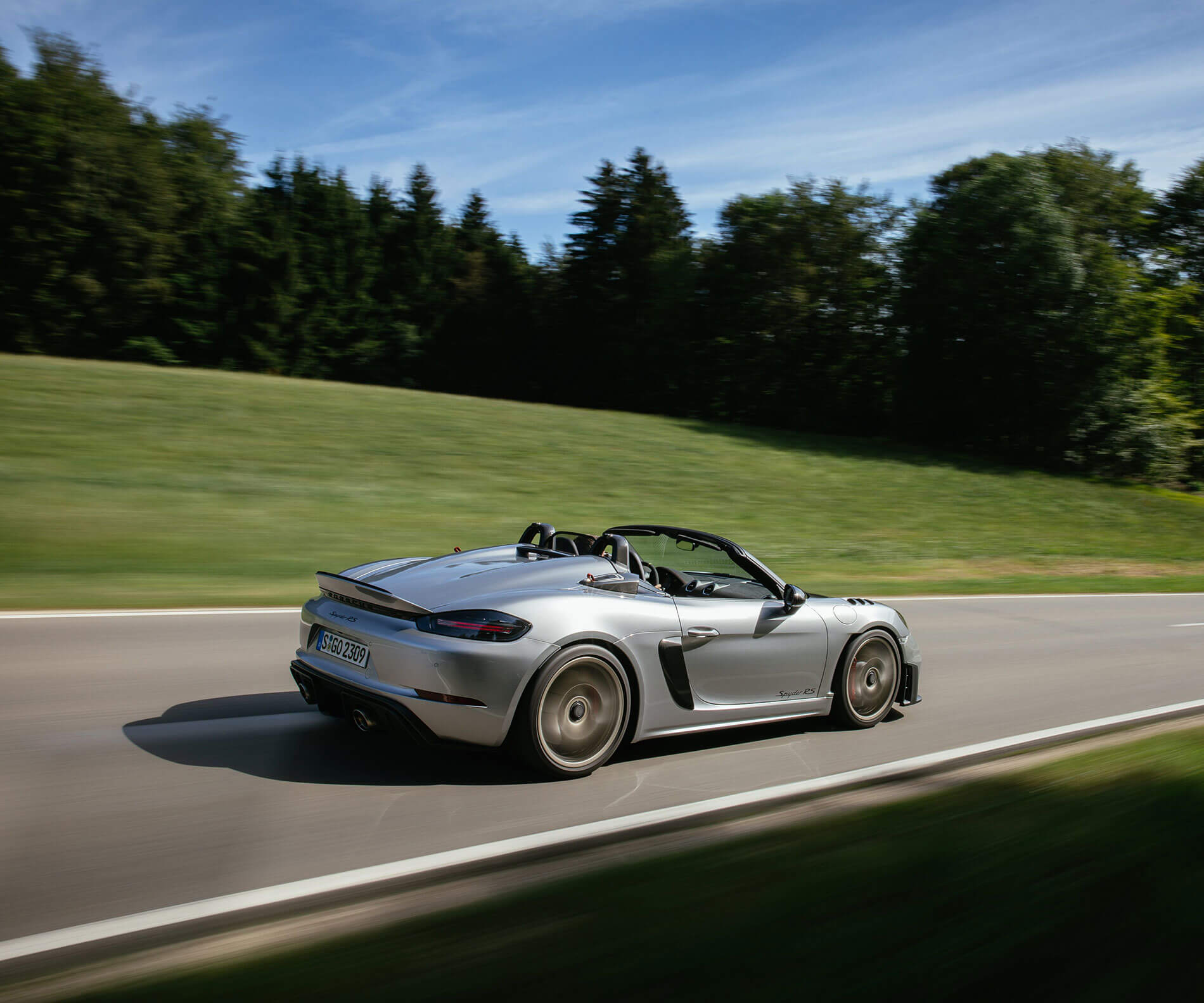BECOME AN INSIDER
Every fortnight, our newsletter provides you with exciting news from the world of mechanical watches and the latest stories from our magazine.
In the heart of the Allgäu, nestled between orchards and hiking trails, little-used but perfectly engineered German country roads with smooth curves provide the best routes for driving. The Swabian Jura is one of Germany’s lower mountain ranges. With the Black Forest right across from it, the Swabian Jura might not be as well known, even amongst Germans, but is no less beautiful. It encompasses an area 200 kilometres long, and about 20 to 40 kilometres wide, even stretching into Switzerland. While locals celebrate the area as a hiking, climbing, and winter sports region, it is also home to 2,500 stunning caves. The caves indicate that our Germanic ancestors lived here from the Stone Age onwards (incidentally fighting with the Neanderthals over the most beautiful spots). Moreover, the oldest figurative representations of humankind as well as one of the oldest works of art ever known, a 40,000-year-old wild horse made of mammoth ivory, have been found in the area’s caves.
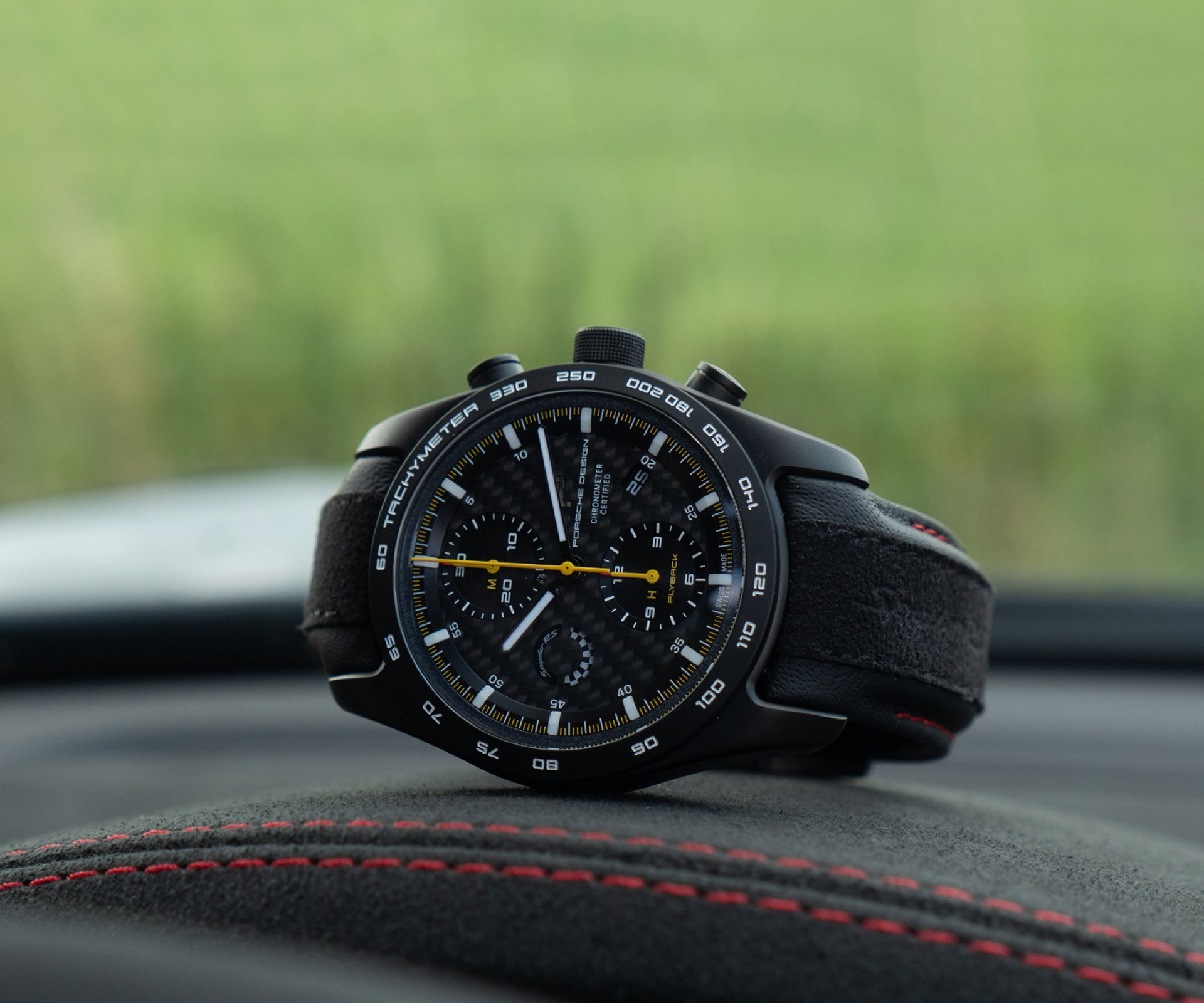
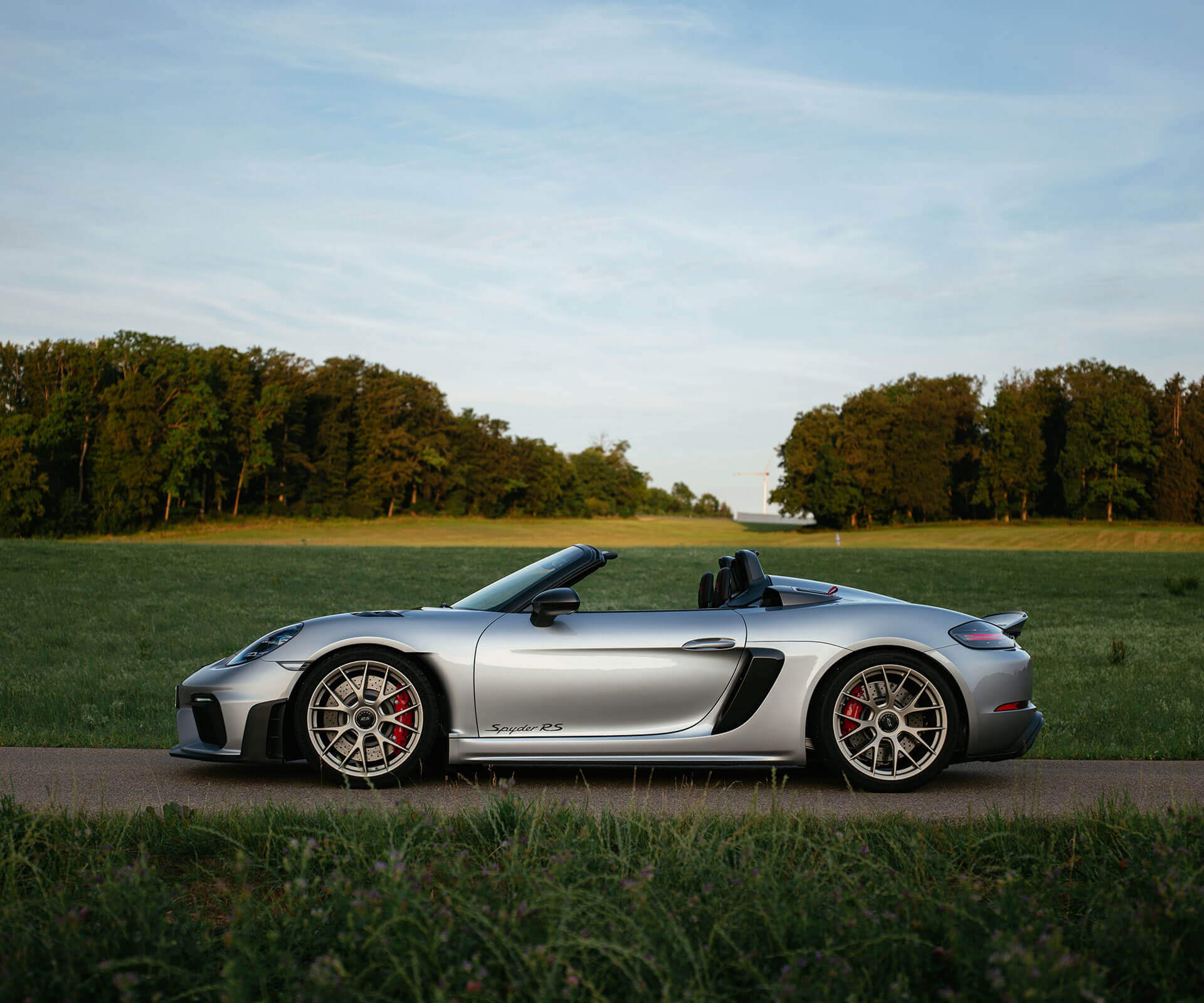
We don’t care to imagine what Porsche will be like in 40,000 years. Still, one thing is certain: the Porsche 718 RS Spyder parked in front of me is the last of its kind: the last edition of the Porsche 718 series with an internal combustion engine. That’s right. There will be no more two-seaters from Porsche with such a mid-engine. Some will rejoice at this news, particularly clever collectors who are already looking forward to the electric successors – as are we. However, this remains a special moment – even for the author, who drives a limited edition 986 Boxster S 550 Spyder. There is no doubt that the new vehicle will make automotive history. The driver feels this for himself as he turns the ignition key and starts the engine – with the matching Porsche Chronograph 718 Spyder RS on his wrist, of course. But more on that later.
What an engine. Exactly 30 years after the presentation of the first Boxster concept study, a vehicle that was first ridiculed and later saved the Porsche Group, Porsche is launching the most powerful version of the now very popular mid-engine roadster by far. With the 718 Spyder RS, it is the first and last time that a high-revving naturally aspirated engine from the 911 GT3 will make its way into an open mid-engine sports car. A 911 GT3 engine in a Boxster is a statement – also for the engineers. It is the first time that the 911 GT3’s free-suction flat-six engine with 500 hp is used in an open mid-engine sports car, the open counterpart to the 718 Cayman GT4 RS.
Porsche is celebrating another anniversary with this car. Besides releasing the first Boxster prototype 30 years ago, the first 550 Spyder was launched exactly 70 years ago. It is the renowned ancestor of the Spyder legends and was used in racing from 1953 to 1959. These vehicles weighed only 550 kilos and won legendary races such as the Carrera Panamericana and the Targa Florio in the 1.5 litre class. This model was replaced by the Porsche 718 RSK Spyder, which was also very successful in the World Sports Car Championship.
The Swabian Jura is considered an ideal starting point – especially for motorbike trips of all kinds – due to its sparsely populated, densely wooded areas and the winding, long ascents and descents, as well as the curved high plateau stretches. At first reverently, later incited by the incomparable sound of this monstrous engine, I glide through the Swabian Jura. I am glad that no biker crosses my path today, even though the ride feels similarly light-footed in terms of weight. For car and motorbike fans, the region is particularly fascinating because together, nature and the industrious Swabians have created roads of every conceivable curve radius – from a hairpin bend to an elongated S-curve. In principle, the Swabian Jura resembles a huge rally circuit. It is akin to the Isle of Man, although accessing it is much easier. Especially during the week, the car traffic here is limited, so you can experience something that seems like a dream come true for city dwellers: boundless driving, occasionally interrupted by the odd milk truck.
While the 550 Spyder with its 1.5-litre four-cylinder engine only had 135 hp (later, the RSK Spyder was upgraded to a maximum of 239 hp) in 1953, there is no comparison with this road car with its 500 hp: I am sitting right in front of the same lightweight engine with a high-revving concept, which is usually located far back in the rear of the Porsche 911 GT3 Cup racing car. With a displacement of four litres, the six-cylinder engine quickly revs up to 9,000 revolutions and develops a maximum torque of 450 Newton metres. Combined with the short-ratio seven-speed PDK gearbox, the flat-six engine accelerates to 100 kilometres per hour in 3.4 seconds. In 10.9 seconds, it reaches 200 kilometres per hour. Compared to the 718 Spyder without the ‘RS’, the new one is 80 hp more powerful and accelerates to 100 km/h half a second faster. The top speed, which is impossible to achieve legally here, is 308 instead of 300 km/h.
Like every modern RS model, the new 718 Spyder RS comes exclusively with the Porsche dual-clutch (PDK) transmission. Why isn’t there a manual transmission? There is a simple reason: you cannot combine this engine with the standard transmission from the Spyder because revs and power would be too much of a good thing. Nevertheless, the PDK transmission, with its individual throttle valves on the engine, makes for a lot of fun and is clearly the right option.
Connoisseurs will be aware that converting a coupé into a convertible usually results in a heavier vehicle. Not so at Porsche: in addition to the more powerful engine, the lower weight is also responsible for the substantial performance increase: at 1,410 kilograms, the Spyder RS is 40 kilograms lighter than a comparable standard 718 Spyder and even weighs five kilograms less than the closed 718 Cayman GT4 RS. Therefore, the Spyder RS also represents the pinnacle of the model series, which has been on the market since 2016, in terms of weight. Yet things are able to get even lighter.
The regular 718 Boxster’s complete soft top weighs 35 kilos, making it the best in class. In comparison, the Spyder’s manual soft top only weighs 26 kilos. Here, the entire soft top system just weighs 18.5 kilos, making it 5 kilos lighter than the closed GT4 RS. It doesn’t sound like much, but it is a statement to competitors as open-top vehicles are generally between 50 and 100 kilos heavier than the closed ones. If you fully remove the emergency soft top on nice days, which can be done in two simple steps, you can even save on another 8 kilos.
Which exterior colour to go for? Without a doubt, GT Silver is the only colour that suits a vehicle with a GT3 engine for the author, because in the past, silver was the colour reserved for exceptional Porsche models. However, in addition to four plain colours and three metallic paints, including the new Vanadium Grey Metallic and the special colours Arctic Grey, Sharkblue and Star Ruby Neo, the ‘Paint to Sample’ programme, totalling 114 colours, is available for the first time. If the suitable colour is not yet among these options, customers can bring their favourite colour to Porsche and, thanks to the ‘Paint to Sample Plus’ programme, pay as much for the paint alone as for the entire Weissach package. But anyone already writing automotive history should also want to add a personal touch to the last 718 of its (combustion) kind.
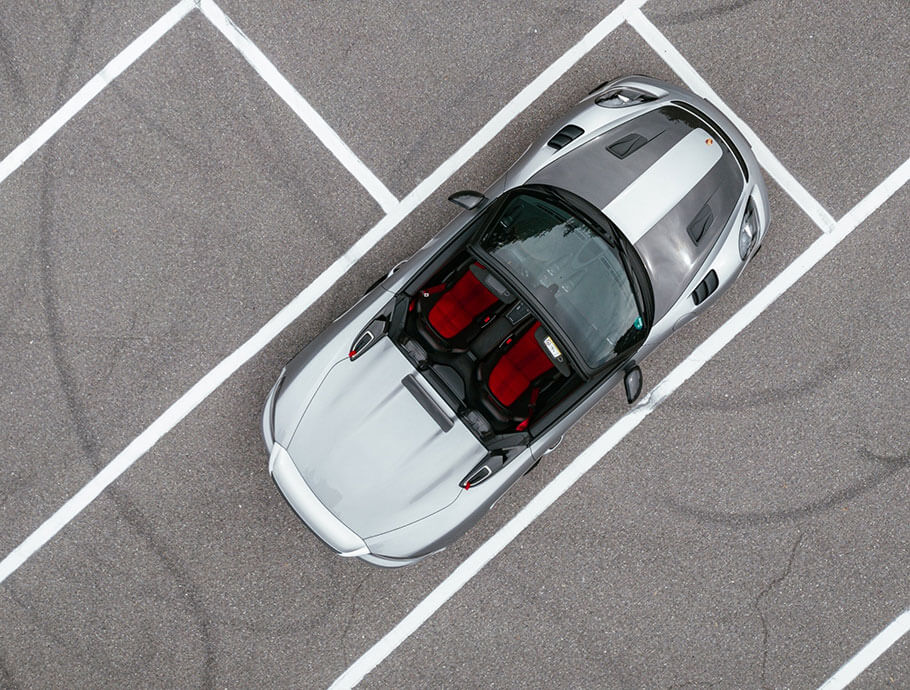
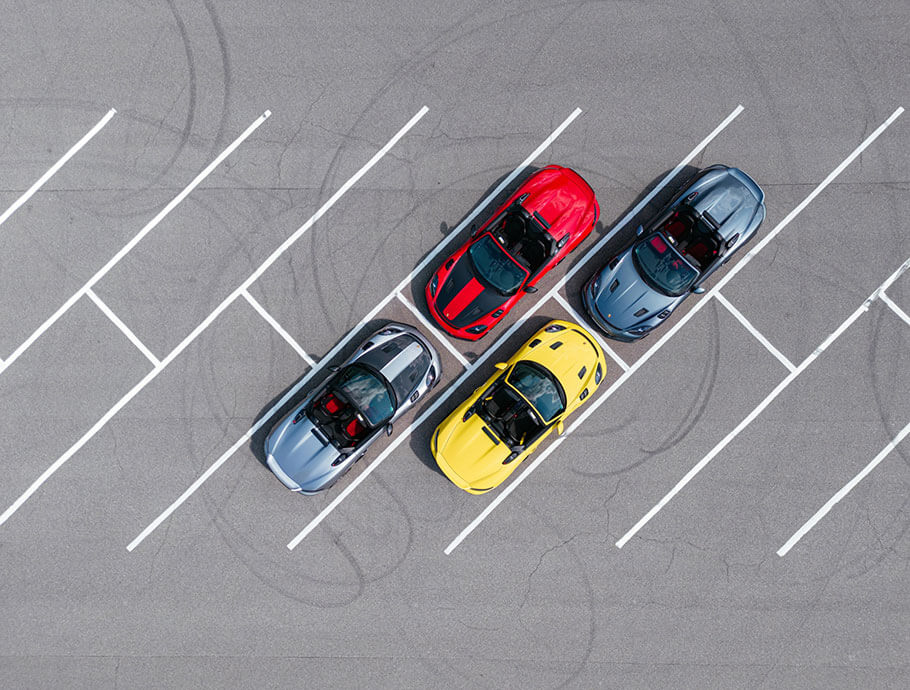
What can be easily written has now turned into reality at Porsche, namely experiencing motorsport on the wrist. What does that mean? It has already been four years since the subsidiary Porsche Design, together with the in-house manufacture in Solothurn, Switzerland, has started to immortalise the rarest and most coveted vehicle models through matching and equally rare wristwatches for their drivers. Generally, watches for GT vehicles are not limited in number but are naturally of interest to collectors due to their high price and the lower production numbers associated with them. This is because all watches are always reserved exclusively for the buyers of the respective vehicle. This means that if a limited-edition vehicle is discontinued and not all customers have ordered a matching watch, Porsche will not allow more watches onto the market. Insiders are currently assuming a take rate of up to 50 percent for the limited-edition chronographs matching the special vehicle editions.
With vehicle-related watches, it should also be noted that there are sometimes different design packages. For example, the Dakar chronograph from 2022 is available in the striking Rallye design (Rothman’s) and in the ‘regular’ version. The 718 Spyder RS vehicle currently comes with the Weissach package, also available for the watch. These versions then differ again in each case. In other words, there is never one watch for the vehicle, but as a rule, always customized versions that may differ from the one communicated in the press images.
The accompanying Porsche Design Chronograph 718 Spyder RS chronograph is the second youngest model in this exclusive series of 14 models since 2019 (because another model has just been added to the 911 S/T with the Chronograph 1, see our story here).
The lightweight titanium case aligns with Porsche’s lightweight construction philosophy and is reminiscent of the first worldwide titanium watches that Porsche Design can claim for itself. The chronograph can also be customized in the same way as the 718 Spyder RS, starting with the case (available in natural titanium or black titanium). The bezel is available in the corresponding colour and with a tachymeter scale or minute scale. How to try it all out? Digitally is the best way forward. The Porsche Design watch configurator remains unique across the entire watch industry.
Porsche knows its vehicle fans and offers, for example, the individual colour ring around the dial in all available Spyder RS standard, metallic and special colours. However, 114 other ‘Paint to Sample’ colours are also possible – including numerous historic Porsche colours.
Framed by the glass-bead blasted titanium caseback in the same colour as the case, the Porsche Design WERK 01.200 with COSC certification is based on a Sellita movement exclusively finished by Porsche Design. The movement has a flyback function that enables the watch to be started, stopped, and reset in a single operation.
Naturally, these watches are not available at watch dealers. Exclusively available for buyers of the new 718 Porsche Spyder RS and Porsche 718 Spyder RS with Weissach package, the Porsche Design Chronograph 718 Spyder RS can be found at Porsche Centres or online at porsche-design.com, making these models all the more enticing.
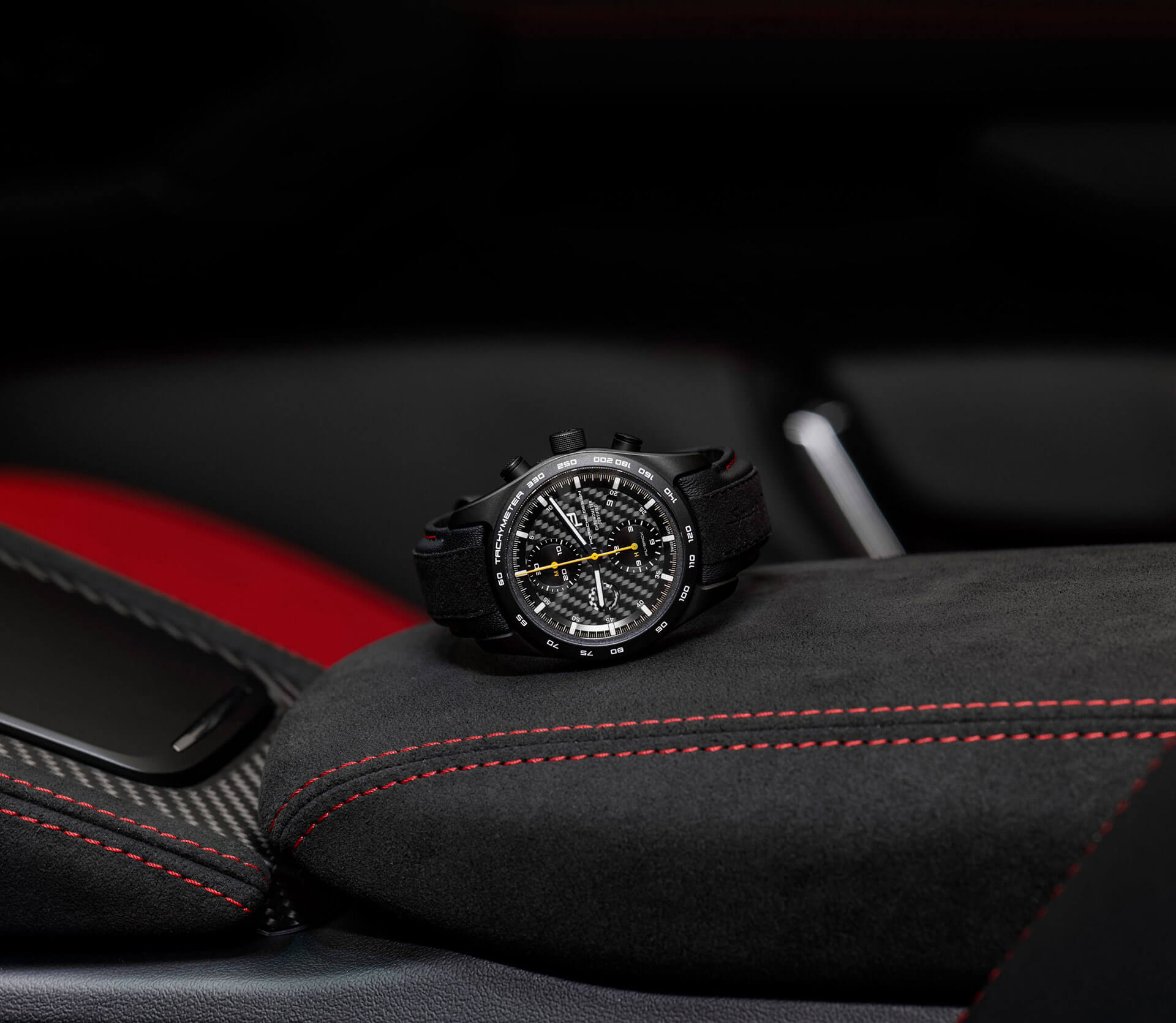
Made of the same smooth black leather used for the vehicle and an attachment made of black Race-Tex with a ‘Spyder RS’ embossed at the six o’clock position, the leather strap included in the scope of delivery emphasises the close connection to the 718 Spyder RS. The contrasting stitching is available in Carmine Red or Arctic Grey. Upon request, the chronograph can also be equipped with titanium straps and a titanium clasp. All straps have a quick-change mechanism and a folding clasp with pushers in the same colour as the case.
As these watches are only available to car owners, it is pointless to only think about collecting these very rare watches – unless one purchases the car as well. Apart from the fact that certain vehicle models are practically sold out as soon as they are announced, this would be quite an expensive indulgence when it comes to the current vehicle editions. Nevertheless, Porsche Design and the parent company, Porsche, are demonstrating foresight and sensitivity with the concept of watches accompanying special vehicles. Identifying owners of rare models by their watch is also a convenient extension of the brand’s reach. After all, the car cannot be taken to the hotel bar. At the same time, in the long run, future car collectors will ask first-time buyers for the corresponding watch when purchasing their vehicles so that the collector’s item is complete. Moreover, those buying classic Porsche Design chronographs will benefit from the increased appreciation on behalf of the car collector scene, as it adds to the Porsche Design’s appeal by additional emotional value to one of the most sought-after car collector brands in the world. Even though the Porsche 718 Spyder will be the last of its kind, the next chapter of Porsche Design chronographs has only just begun.
